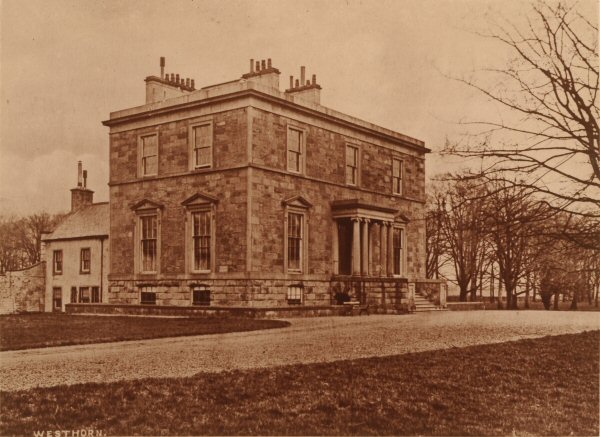

THE lands of Westthorn lie on the right bank of the Clyde, between Belvidere and Dalbeth, all on the line of the London road, about three miles eastward from Glasgow. Two centuries ago Westthorn belonged to the old Glasgow family of Wardrop. In 1710, when Hamilton of Wishaw wrote his volume on Lanarkshire, there was "a manor-place" or mansion on Westthorn, which he describes as a "pleasant and convenient seat." He also states that John Wardrop was then the proprietor, both of Westthorn, and of the adjoining property of Dalbeth.
The son of this ancient owner, named Henry, succeeded to Westthorn, and about the middle of last century espoused Annabella, daughter of John Gray of Dalmarnock, and sister of the well known Robert Gray of Carntyne, a Deputy Lieutenant of Lanarkshire. Westthorn was alloted as her jointure-house in 1756. She long outlived her husband, and resided at this beautiful country seat many years. Their only daughter, Elizabeth, succeeded to Westthorn estate as heiress of her father, and married James Dennistoun, Captain in the 50th Regiment of Foot. Subsequently, Westthorn belonged to Alexander Bruce Dennistoun, and thereafter to James Sword, jun., merchant in Glasgow.
Mr. Sword was the son of James Sword, senr., of Annfield. He wrought extensively the coal in Westthorn, and long resided in the antique mansion on that property.
About 1819, Westthorn was sold to Thomas Harvie, distiller in Glasgow. He soon after built the elegant mansion represented in the photograph. Mr. Harvie became famous as the defender in the well known lawsuit, at the instance of a committee representing the public, for removing two massive dykes which he had erected at the east and west boundaries of Westthorn, at right angles with, and close down to the brink of the Clyde for the purpose of shutting out the public from a pathway said to have existed from time immemorial along the right bank of the river from Carmyle to the green of Glasgow. These formidable walls were assaulted by a crowd of people, and a riot ensued, which was quelled by the military under the directions of the Sheriff. After an obstinate litigation, in which the case was tried in Edinburgh in the Jury Court, and repeatedly appealed to the House of Lords, Mr. Harvie was defeated, and a right of passage fixed of a certain breadth along the waterside grounds of Westthorn, and corresponding openings made in the wall, in which state matters remain. The case made a great noise forty years ago, but, like many other things, is now nearly forgotten.
Westthorn was subsequently sold, and is now the property of Mr. Farie of Farme.
The date of the old building is unknown. Additions were made to it in 1830.
Back to Contents